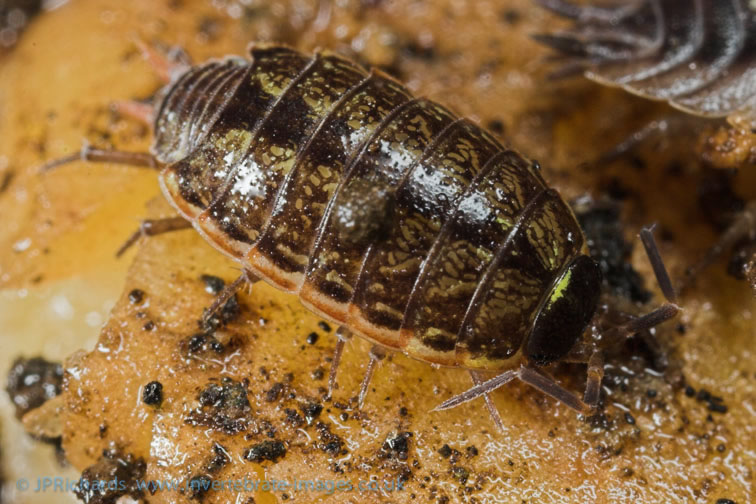Philoscia muscorum (Scopoli, 1763)
Common name
Status:
GB IUCN status: Least Concern
ID Difficulty
Identification
This medium sized species (to 11mm) with a stepped body outline bearing a distinctive dark dorsal stripe. The antennae have three flagella segments and it lacks pleopodal lungs. It come in a variety of colour forms (see images), but as a rule the head is typically uniformly pigmented, often black, and usually noticeably darker than the body. It typically runs rapidly when disturbed.
It has recently become apparent that a second species of Philoscia - P. affinis - also occurs in Britain, which differs on a number of subtle characters (which are highlighted in Gregory, 2020). Otherwise confusion is most likely with Ligidium hypnorum (flagella of numerous bead-like segments) or Porcellionides cingendus (flagella of two segments, plus two pairs of pleopodal lungs). Orange colour forms have been repeatedly mistaken for Androniscus dentiger by inexperienced observers.
Distribution
P. muscorum is an abundant species in lowland England and Wales, but becomes increasingly sparse in northern England and becomes restricted to coastal sites and low-lying river valleys in Scotland. However, the distribution of this species in Ireland, north Wales, north-west England and especially western Scotland is confused as most of the sites shown on the NBN map (opposite) and in the 'Atlas' (Gregory, 2009) pre-date the realisation in 2017 that P. affinis also occurs in Britain and Ireland. In western Scotland, at least, it is likely that many of the older records are erroneous and actually refer to P. affinis (Gregory, 2020).
Habitat
It has a strong preference for grassy sites of all sorts, and tends to avoid dense woodland (a habitat more suited to the recently discovered P. affinis). Although often numerous within grassland swards, it is most easily found beneath refuge sites, such as dead wood, stones or even dried cowpats.
This summary is based on the detailed account in Gregory (2009).
References
Gregory, S. (2009) Woodlice and Waterlice (Isopoda: Oniscidea & Asellota) in Britain and Ireland. Field Studies Council/Centre for Ecology & Hydrology.
Links
World List of Marine, Freshwater and Terrestrial Isopod Crustaceans: https://www.marinespecies.org/isopoda/aphia.php?p=taxdetails&id=258268











